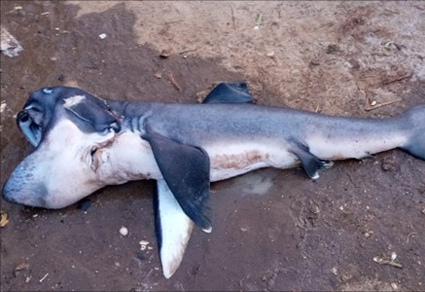Abstract
The megamouth shark Megachasma pelagios (Lamniformes: Megachasmidae) was described in 1976 from a specimen caught off Hawaii (Taylor et al. 1983) and is the only extant member of its family and genus (Diez et al. 2022). From 1976 to 2010 M. pelagios was considered rare, with only 50 individuals recorded globally during that time (Nakaya 2010). In recent years it is apparent that it is more common and widespread than previously thought, with 273 confirmed records to date across 16 countries in the Atlantic, Indian and Pacific Oceans (Yu et al. 2021; Diez et al. 2022; Skelton et al. 2023). This species is classified as Least Concern on the IUCN Red List of Threatened Species, as it is globally distributed and does not appear to be heavily impacted by fisheries (Kyne et al. 2019).
References
- Barnett, R. (1997) The shark trade in mainland Tanzania and Zanzibar. In: Marshall, N.T. & Barnett, R. (Eds.), The trade in sharks and shark products in the Western Indian and Southeast Atlantic Oceans. TRAFFIC East/Southern Africa, Nairobi, pp. 39–66.
- Bianchi, G. (1985) Field guide to the commercial marine and brackish water species of Tanzania. FAO Species Identification Sheets for Fishery Purposes. Project No. TCP/URT/4406, Food and Agriculture Organization of the United Nations, Rome, 250 pp.
- Braulik, G., Kasuga, M. & Majubwa, G. (2020) Local ecological knowledge demonstrates shifting baselines and the large-scale decline of sawfishes (Pristidae) in Tanzania. African Journal of Marine Science, 42 (1), 67–79. https://doi.org/10.2989/1814232X.2020.1728379
- Diez, G., Ruiz, J. & Salgado, A. (2022) Record of three specimens of megamouth sharks—Megachasma pelagios—in tropical tuna purse seine fisheries in the Atlantic and Indian Oceans. Journal of the Marine Biological Association of the United Kingdom, 102, 153–156. https://doi.org/10.1017/s0025315422000224
- Ebert, D.A., Dando, M. & Fowler, S. (2021) Sharks of the World. Princeton University Press, Princeton, 608 pp. https://doi.org/10.1515/9780691210872
- Environmental Justice Foundation. (2020) Globally elusive megamouth shark landed in Liberia. Available from: https://ejfoundation.org/news-media/elusive-megamouth-shark-landed-in-liberia (accessed 4 October 2023)
- FAO. (2023) INDIAN OCEAN, WESTERN (Major Fishing Area 51). Fisheries and Aquaculture Division [online], Rome. Available from: https://www.fao.org/fishery/en/area/51/en (accessed 4 October 2023)
- Kyne, P.M., Liu, K.M. & Simpfendorfer, C. (2019) Megachasma pelagios. The IUCN Red List of Threatened Species 2019: e.T39338A124402302. Available from: https://www.iucnredlist.org/species/39338/124402302 (accessed 4 October 2023) https://doi.org/10.2305/IUCN.UK.2019-1.RLTS.T39338A124402302.en
- Nakaya, K. (2010) Biology of the Megamouth Shark, Megachasma pelagios (Lamniformes: Megachasmidae). In: Uchida, S. (Ed.), Proceedings of the International Symposium, into the Unknown, Researching Mysterious Deep-Sea Animals. Churaumi Aquarium, Okinawa, pp. 69–83.
- Schaeffer, D. (2004) Assessment of the Artisanal Shark Fishery and Local Shark Fin Trade on Unguja Island, Zanzibar. Independent Study Project Collection, 46 pp.
- Séret, B. (1995) First record of a megamouth shark (Chondrichthyes, Megachasmidae) in the Atlantic Ocean, off Senegal, Cybium, 19 (4), 425–427.
- Shehe, M.A. & Jiddawi, N.S. (1997) The status of shark fisheries in Zanzibar. In: Fowler, S.L., Reed, T.M. & Dipper, F.A. (Eds.), Elasmobranch Biodiversity, Conservation and Management: Proceedings of the International Seminar and Workshop. The IUCN Species Survival Commission, Sabah, pp. 158–161.
- Skelton, Z.R., Kacev, D., Frable, B.W., Chang, A., Costescu, V., Stabile, D. & Ebert, D.A. (2023) Two’s company: first record of two free-swimming megamouth sharks, Megachasma pelagios (Lamniformes: Megachasmidae), off the California coast. Environmental Biology of Fishes, 106 (4), 717–724. https://doi.org/10.1007/s10641-023-01406-0
- Smale, M.J., Compagno, L.J. V & Human, B.A. (2002) First megamouth shark from the western Indian Ocean and South Africa. South African Journal of Science, 98, 349–350.
- Spalding, M., Fox, H., Allen, G., Davidson, N., Ferdaña, Z., Finlayson, M., Halpern, B., Jorge, M., Lombana, A., Lourie, S., Martin, K., McManus, E., Molnar, J., Recchia, C. & Robertson, J. (2007) Marine Ecoregions of the World: A Bioregionalization of Coastal and Shelf Areas. BioScience, 57 (7), 573–583. https://doi.org/10.1641/B570707
- Taylor, L., Compagno, L. & Struhsaker, P. (1983) Megamouth—a new species, genus, and family of lamnoid shark (Megachasma pelagios, family Megachasmidae) from the Hawaiian Islands. Proceedings of the California Academy of Sciences, 43, 87–110.
- Temple, A.J., Wambiji, N., Poonian, C.N.S., Jiddawi, N., Stead, S.M., Kiszka, J.J. & Berggren, P. (2019) Marine megafauna catch in southwestern Indian Ocean small-scale fisheries from landings data. Biological Conservation, 230, 113–121. https://doi.org/10.1016/j.biocon.2018.12.024
- White, W.T., Adrim, M. & Sumadhiharga, K. (2004) A juvenile megamouth shark Megachasma pelagios (Lamniformes: Megachasmidae) from northern Sumatra, Indonesia. The Raffles Bulletin of Zoology, 52, 603–607.
- Yu, C.J., Joung, S.J., Hsu, H.H., Lin, C.Y., Hsieh, T.C., Liu, K.M. & Yamaguchi, A. (2021) Spatial-temporal distribution of megamouth shark, Megachasma pelagios, inferred from over 250 individuals recorded in the three oceans. Animals, 11 (10), 2947. https://doi.org/10.3390/ani11102947


